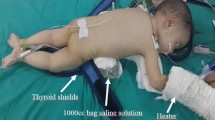Abstract
We reported our experience with percutaneous nephrolithotomy in children and compared the outcomes, including the morbidity and success rates, regarding the instruments of different sizes. One hundred and seventy-three paediatric patients, who underwent percutaneous nephrolithotomy in our clinic between 1999 and 2013, were assessed. According to the size of instruments used during surgery, three different groups were formed and the pre- and postopeartive outcomes were compared between the groups. 76 girls and 97 boys with a mean age of 9.24 (≤17) years were assessed. Stone-free rates were 75.6 % in group 1 (n = 82) using 17 F nephroscope, 79.4 % in group 2 (n = 73) using 24 F nephroscope and 72.2 % in group 3 (n = 18) using 26 F nephroscope. Postoperative fever was seen in four, five and one patient in group 1, 2 and 3, respectively. Urinary infection was seen in one patient in group 1 and four patients in group 2. Mean haematocrit drop and stone burden were significantly lesser in group 1. No significant difference was seen in the duration of nephrostomy and hospitalization between the groups. The success rates obtained in the groups using different instrument types (paediatric or adult) were similar. However, age, weight, height, stone burden and bleeding were significantly lesser in group 1 that used paediatric type of instrument. As the most frequent complication of PNL, bleeding seems to be associated with stone burden, the diameter of dilatation and the calibre of instrument. To decrease the particular complications, paediatric type of instruments are convenient and do not affect the success.
Similar content being viewed by others
References
Tellaloglu S, Ander H (1984) Stones in children. Turk J Pediatr 26:51–60
Djelloul Z, Djelloul A, Bedjaoui A et al (2006) Urinary stones in Western Algeria: study of the composition of 1,354 urinary stones in relation to their anatomical site and the age and gender of the patients. Prog Urol 16(3):328–335
Sarica K (2006) Pediatric urolithiasis: etiology, specific pathogenesis and medical treatment. Urol Res 34(2):96–101
Ozden E, Sahin A, Tan B et al (2008) Percutaneous renal surgery in children with complex stones. J Pediatr Urol 4(4):295–298
Nouralizadeh A, Basiri A, Javaherforooshzadeh M et al (2009) Experience of percutaneous nephrolithotomy using adult-size instruments in children less than 5 years old. J Pediatr Urol 5(5):351–354
Bilen CY, Kocak G, Kitirci O et al (2007) Percutaneous nephrolithotomy in children: lessons learned in 5 years at a single institution. J Urol 177(5):1867–1871
Fernstrom I, Johannson B (1976) Percutaneous pyelolithotomy. A new extraction technique. Scand J Urol Nephrol 10:257–259
Woodside JR, Steven GF, Stark GL et al (1985) Percutaneous stone removal in children. J Urol 134(6):1166–1167
Mishra S, Sharma R, Garg C et al (2011) Prospective comparative study of miniperc and standard PNL for treatment of 1–2 cm size renal stone. BJU Int 108(6):896–899
Kroovand RL (1997) Pediatric urolithiasis. Urol Clin North Am 24:173–184
Tekin I, Tekgul S, Bakkaloglu M et al (1998) Results of extracorporeal shock wave lithotripsy in children, using the Dornier MPL 9000 lithotriptor. J Pediatr Surg 33:1257–1259
Demirkesen O, Tansu N, Yaycioglu O et al (1999) Extracorporeal shockwave lithotripsy in the pediatric population. J Endourol 13:147–150
Nazli O, Cal C, Ozyurt C et al (1998) Results of extracorporeal shock wave lithotripsy in the pediatric age group. Eur Urol 33:333–336
Tekgul S, Riedmiller H, Dogan HS et al (2013) Guidelines on pediatric urology. EAU guidelines, pp 75–83
Guven S, Istanbulluoglu O, Ozturk A et al (2010) Percutaneous nephrolithotomy is highly efficient and safe in infants and children under 3 years of age. Urol Int 85(4):455–460
Unsal A, Resorlu B, Kara C et al (2010) Safety and efficacy of percutaneous nephrolithotomy in infants, preschool age, and older children with different sizes of instruments. Urology 76(1):247–252
Kapoor R, Solanki F, Singhania P et al (2008) Safety and efficacy of percutaneous nephrolithotomy in the pediatric population. J Endourol 22(4):637–640
Afshar K, McLorie G, Papanikolaou F et al (2004) Outcome of small residual stone fragments following shock wave lithotripsy in children. J Urol 172:1600–1603
Desai M (2005) Endoscopic management of stones in children. Curr Opin Urol 15(2):107–112
Rizvi S, Nagvi S, Hussain Z et al (2003) Management of pediatric urolithiasis in Pakistan: experience with 1,440 children. J Urol 169(2):634–637
Zeren S, Satar N, Bayazit Y et al (2002) Percutaneous nephrolithotomy in the management of pediatric renal calculi. J Endourol 16:75–78
Traxer O, Smith TG, Pearle MS et al (2001) Renal parenchymal injury after standard and mini percutaneous nephrostolithotomy. J Urol 165:1693–1695
Raza A, Turna B, Smith G et al (2005) Pediatric urolithiasis: 15 years of local experience with minimally invasive endourological management of paediatric calculi. J Urol 174(2):682–685
Acknowledgments
We do not acknowledge any person or institute for this research.
Conflict of interest
The authors declare no conflict of interest.
Author information
Authors and Affiliations
Corresponding author
Rights and permissions
About this article
Cite this article
Altintas, R., Oguz, F., Tasdemir, C. et al. The importance of instrument type in paediatric percutaneous nephrolithotomy. Urolithiasis 42, 149–153 (2014). https://doi.org/10.1007/s00240-013-0626-z
Received:
Accepted:
Published:
Issue Date:
DOI: https://doi.org/10.1007/s00240-013-0626-z




